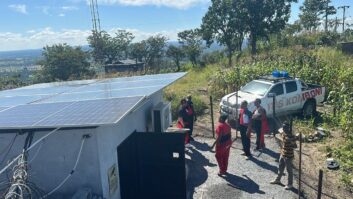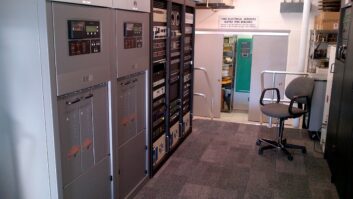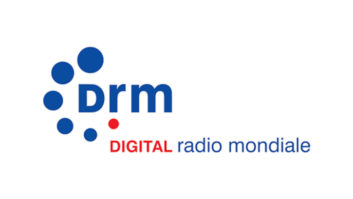The Pilot Innovation Challenge, an initiative of the National Association of Broadcasters, �recognizes creative ideas that leverage technological advances in the production, distribution and display of engaging content.� More than 150 ideas were submitted to address the challenge question, �What is an unconventional way broadcasters and other local media could serve communities?
Radio magazine recently spoke with Michael Ricciardi, a freelance writer and research, whose Resilience � Preparing for Climate Change project is one of the finalists in the Challenge. Winners will be announced on Nov. 13.
Radio:Please describe the Resilience project and the technology behind it.
Michael Ricciardi: The Resilience project proposes a suite of services to local communities to help community members, groups and organizations prepare for, and adapt to, climate change impacts � working with/through local TV/radio stations.
These services may include data collecting and analytics (e.g., collected via cheap, ground-based sensor networks, CubeSat satellite networks, with the TV/radio station acting as data �hub�), preparedness tools (e.g., mobile/SMS messaging/bulletin services/apps for monitoring/mitigating local GHG emissions and reporting this data), and educational/instructional resources (e.g., lectures or workshops offered through local colleges/universities or nonprofits).
The impacts from climate change may be gradual or sudden, sporadic or continuous, and likely will be quite variable [in local extremes] depending upon the region of the country involved, as the ecological, geographical and native weather conditions vary greatly from region to region in the US. In many case, climate change impacts will be dramatic and can potentially impact an entire region�s infrastructure or economy (as in the cases of severe flooding, prolonged drought impacting our nation�s farm belt, or protracted wildfire seasons).
Climate change will also incur costs � impact costs, mitigation costs, and recovery costs. Some of the financial costs of climate change impact can be reduced or mitigated with proper collective actions (e.g., undertaking community climate risk assessments) and preparedness policies (e.g., developing disaster plans).
Resilience proposes that local TV/radio stations positioned themselves as the central hubs or �integrators� of these services, on a continuous basis, thus making them indispensable to local communities��� on-going efforts to successfully meet the challenges of variable impacts from climate change.
Radio:What was the inspiration behind the service?
MR: The idea of Resilience has been floating around in my brain for quite some time. It was no doubt partly inspired by my years as a science writer (and thus, as a science reader) and reporter. As it became clear to me that climate change would impact some communities more than others (e.g., rural/isolated or poorer communities), and that these impacts would be highly variable from region to region � within the US, globally even more so, I came to see that said impacts would be critical challenges for some, and that successfully dealing with them would require a certain capacity or trait: resilience. But it was still a mostly unformed idea. What gave it form was the Pilot challenge. The Pilot challenge provided a structure, or context, in which to situate this idea, to actualize this idea, by targeting and fulfilling local TV/radio stations� community service missions [through offering Resilience services to the local communities they serve].
Radio:How do you expect Resilience will affect the broadcast industry?
MR: In the medium to long term, I believe the impact will be highly positive, insofar as it will be providing real value to the community in addition to providing general news and entertainment. Resilience will help make local stations the central hubs and integrators of climate change preparedness/adaptation data, tools, and resources. I foresee a type of social contagion happening within a short time frame (2�4 years) in which more and more radio and TV stations adopt and implement locally-tailored Resilience projects and services�eventually covering the entire US. Resilience-type projects/initiative are, in my opinion, inevitable. At the heart of this movement will be the local TV/radio stations that were/are prescient enough to identify the critical and increasing need for such services in the not-so-far-off future.
Radio:Are there tools that make Resilience more ideal for one type of media rather than another? Do you anticipate local radio stations or television stations using it?
MR: I anticipate both local TV and radio stations to provide Resilience services � perhaps working cooperatively towards this goal. In the case of data communication: both media (radio and TV) can communicate this, however, data visualization [which helps people understand data better] is best served through a visual medium. That said, many radio stations have web presences and/or have radio shows that are televised. Thus, listeners to a radio show or segment dealing with climate change impacts can look up a webpage for �more information� via their laptops or mobile devices if they so choose. As an example, a local college or university may be conducting a �citizen science� project centering on climate science. Interested citizens can sign up via a companion website, take part in the project and also gain valuable experience and knowledge. This web presence for audio media will help equalize the data communication/visualization �divide� that one might assume exists between TV and radio. Beyond this function, both TV and radio have inherent advantages they can exploit to best provide Resilience services.
Radio:What should readers know about the technology and its practical implications?
MR: There is no single technology that the Resilience project depends on to �make it work.� A number of existing and fairly new technologies can be utilized to provide the services noted. Those already noted are by no means the only ones but are simply some of the more practical and useful technologies. Accessing some of these may have some associated costs but they were chosen because of the relative affordability.
For example, designing and implementing a local sensor network or web of sensor networks (e.g., for monitoring soil moisture content in local farming communities) can be achieved cheaply with �off-the-shelf� components (with the set-up perhaps assisted by engineers from the local university) � with sensor data being transmitted via radio to a central hub for acquisition/aggregation/analysis/announcing (A4) � and having real-world implication: continuous monitoring of local soil moisture content can help predict flooding, monitor droughts and even inform farmers as to which crops to plant (as just one example of one type of data collecting/usage). This can potentially save a community considerable cost and even enable it to thrive despite the climate change impacts.
GeoOptics CubeSats (also known as �nanosatellites�) can be deployed cheaply and in larger numbers than traditional �big science� satellites. These small scale, low-earth orbit (LEO) satellites provide finer time resolution than large NOAA or NASA satellites and can therefore supplement the data from these latter types to provide continuous updates in key climate data metrics (e.g., temperature, pressure, and humidity at various altitudes). Acting as a community liaison, a radio/TV station can partner with community groups and local university aeronautics departments (and/or their private space sector affiliates) to coordinate a CubeSat deployment that will serve the specific local community’s weather and climate impact needs. CubeSat weather data from private space sector start-ups is already slated to augment local weather data for NOAA�s weather service by 2018 (GeoOptics and Spire are two such CubeSat companies).
These are just a few examples of what types of technologies can be used and what they can be used for. The nature and type of content offered by any given region�s Resilience services will vary significantly and be shaped by each community�s unique climate change risks and challenges.







